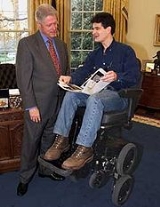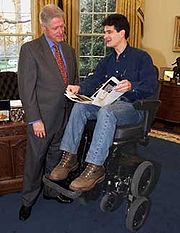
IBOT
Encyclopedia

Wheelchair
A wheelchair is a chair with wheels, designed to be a replacement for walking. The device comes in variations where it is propelled by motors or by the seated occupant turning the rear wheels by hand. Often there are handles behind the seat for someone else to do the pushing...
developed by Dean Kamen
Dean Kamen
Dean L. Kamen is an American entrepreneur and inventor from New Hampshire.Born in Rockville Centre, New York, he attended Worcester Polytechnic Institute, but dropped out before graduating after five years of private advanced research for drug infusion pump AutoSyringe...
in a partnership between DEKA
DEKA
DEKA Research and Development Corporation is a company based in New Hampshire, founded in 1982 by Dean Kamen, consisting of nearly 200 engineers, technicians, and support staff...
and Johnson and Johnson's Independence Technology
Independence Technology
- Discontinuation :Due to an inability to make the business model for the INDEPENDENCE iBOT Mobility System profitable or even reach a break even point, Johnson & Johnson ceased selling the iBot in December 2008. Support for existing users will continue through 2013....
division. It is a medical technology, made to help people with severe mobility problems.
As of 2006 the iBOT retailed for approximately US$26,100 and required a prescription in the U.S. As of 2009, it is no longer available for sale from Independence Technology, but support for existing units will be available until the end of 2013.
Features
The iBOT has a number of features distinguishing it from most powered wheelchairs:- By rotating its two sets of powered wheels about each other, the iBOT can "walk" up and down stairs, much like a cog railway or a rack and pinion with the two wheels as the "teeth" of the gear. The wheels can roll slightly at each step to compensate for a wide range of stair dimensions. When stair-climbing without assistance the user requires a sturdy handrail and a strong grip. With an assistant neither a handrail nor a strong grip are required.
- The iBOT is capable of tethered remote control operation, useful for loading the wheelchair up ramps into vehicles, or "parking" out of the way when not occupied.
- A special software package called iBALANCE receives data via various sensors and gyroscopes, allowing the iBOT to maintain balance during certain maneuvers. For example during curb climbing the seat remains level while parts of the chassis tilt to climb the curb.
- It allows the user to rise from a sitting level to approximately 6 ft. tall, measured from the ground to the top of the head, and depending on the size of the occupant (see illustration above). It does this by raising one pair of wheels above the other to elevate the chassis, while a separate actuator raises the seat slightly more than usual. In this configuration the device is on two wheels, and the 'iBALANCE' software and gyroscope signals control the iBOT to maintain equilibrium, balancing much like the SegwaySegway PTThe Segway PT is a two-wheeled, self-balancing transportation machine invented by Dean Kamen. It is produced by Segway Inc. of New Hampshire, USA. The name "Segway" is a homophone of "segue" while "PT" denotes personal transporter....
scooter (which was a spin-off from the iBOT development). The user may also travel in this "standing" configuration. - It can climb and descend curbs ranging from 0.1 to 5.0 inches, according to the manufacturer's specifications. The limits are determined by the rider's technique and risk tolerance.
- It is capable of traveling through many types of terrain, including sand, gravel, and water up to 3" deep.

